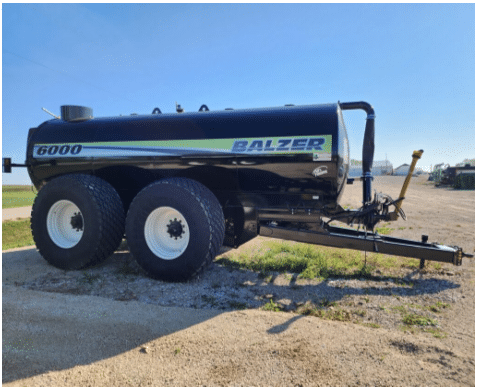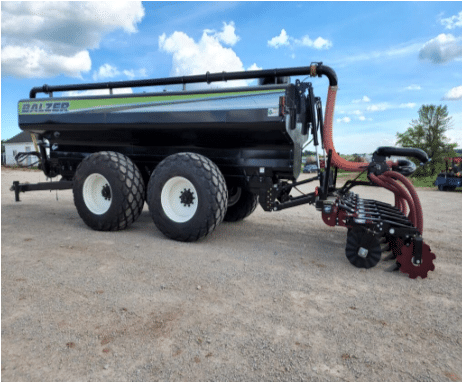Manure Tanker for Sale: Key Features and Buying Considerations for Farmers

Balzer 6000 tanker built to handle liquid manure efficiently — durable, high-capacity, and farm-ready.
Tanker for Sale
Manure handling is one of the most critical components of modern livestock and crop operations. A well-built manure tanker saves time, protects your fields, and ensures valuable nutrients are used efficiently — not wasted. With so many manure tanker for sale, it’s essential to know what features matter most before investing in one that fits your operation.
What Is a Manure Tanker?
A manure tanker is a large-capacity tank designed to haul and apply liquid or semi-liquid manure from storage pits or lagoons to your fields. Tankers play a vital role in manure management systems — especially when dragline systems aren’t practical due to distance, field layout, or topography.
A quality tanker allows you to apply nutrients evenly, minimize odor, reduce runoff, and meet environmental compliance while keeping your farm productive.
Know the Size and Requirements of Your Operation
Before purchasing, consider how much manure you handle in a typical season and how far it needs to be hauled.
- Smaller farms benefit from compact tankers that are easier to maneuver, require less horsepower, and reduce fuel consumption.
- Larger operations often prefer high-capacity units that minimize refilling trips and maximize field efficiency.
Also, match the tanker’s loaded weight to your tractor’s power and towing capacity to ensure smooth operation across your terrain.
Tank Capacity and Construction
Tank capacity varies widely — typically between 2,000 and 10,000 gallons — and the best choice depends on your field size, manure volume, and available horsepower.
When comparing designs:
- Round or elliptical tanks empty more efficiently and reduce material buildup.
- Galvanized or epoxy-coated steel tanks offer excellent corrosion protection.
- Internal baffling helps stabilize loads during transport, improving safety and control.
At Phil’s Pumping & Fabrication, tankers are built to handle the corrosive and abrasive nature of manure, ensuring durability across years of hauling and application.
Pumping and Spreading Systems
Your pump system determines how quickly the tanker can load and unload.
- Look for high-capacity fill and discharge systems, ideally with hydraulic-driven loading arms or top-fill systems for faster turnaround times.
- A vacuum or pressure system can make filling pits cleaner and more controlled.
The spreading system is just as important. Options include:
- Splash plates for general surface spreading,
- Dribble bars for reduced odor and nutrient loss, or
- Injection toolbars for subsurface placement and improved nutrient retention.
Choosing the right configuration depends on your soil type, crop rotation, and regulatory requirements.

Balzer tanker with injector system ensures efficient manure application and improved nutrient retention.
Axles, Tires, and Suspension
Manure is heavy — especially when hauling thousands of gallons.
- Select a tanker with heavy-duty axles, leaf-spring or hydraulic suspension, and flotation tires to reduce soil compaction.
- Tandem and tridem axle setups distribute weight evenly for smoother transport on soft or uneven ground.
- If your routes include public roads, confirm the unit complies with transport width, braking, and lighting requirements.
Reducing compaction during hauling preserves soil structure and helps maintain long-term field health.
Maintenance and Cleaning
Manure tanker handle highly corrosive material, so maintenance is key to longevity.
- Choose a model with easy-access cleanout ports and smooth interior surfaces to prevent buildup.
- Galvanized interiors or epoxy coatings offer extra protection from acids and moisture.
- Rinse your tank after each use to prevent scaling, corrosion, and odor buildup.
Proper upkeep not only extends service life but also preserves resale value if you ever upgrade.
Technology and Efficiency Upgrades
Today’s top manure tankers can integrate precision farming tools for higher accuracy and sustainability.
- Flow meters track nutrient application rates per acre.
- GPS rate control systems prevent over-application and nutrient loss.
- Load sensors and pressure monitors improve safety and allow for real-time adjustments.
Phil’s Pumping & Fabrication builds and outfits tankers with custom pump and application packages designed to meet your farm’s specifications and nutrient management goals.
Final Thoughts
A manure tanker is more than a hauler — it’s an investment in the sustainability and efficiency of your farm. The best model for you depends on your farm size, field layout, manure consistency, and preferred spreading method. Investing in a well-built, properly sized tanker from a trusted manufacturer like Phil’s Pumping & Fabrication ensures years of reliable operation, reduced downtime, and better nutrient management across your acres.
Farmers! Save time and money with the perfect manure tanker. From tank design to spreading systems, learn key buying tips to boost your farm’s productivity. Visit our Instagram page
FAQs
- How long will a manure tanker last?
With proper cleaning and maintenance, a quality tanker can last 10 to 20 years, depending on usage and conditions. - What size is best for a medium-sized farm?
A 3,000–6,000-gallon tanker typically fits most medium farms — balancing capacity with ease of handling and fuel efficiency. - Can one tanker handle both slurry and semi-solid manure?
Yes, if equipped with a compatible pump and manifold system that can handle thicker materials. - How often should I clean a manure tanker?
After every use. Frequent cleaning prevents corrosion and buildup, ensuring smoother operation and longer lifespan. - Is buying new worth it?
Yes. New tankers offer stronger materials, better spreading control, and reduced maintenance costs — often paying for themselves over time through improved efficiency.
